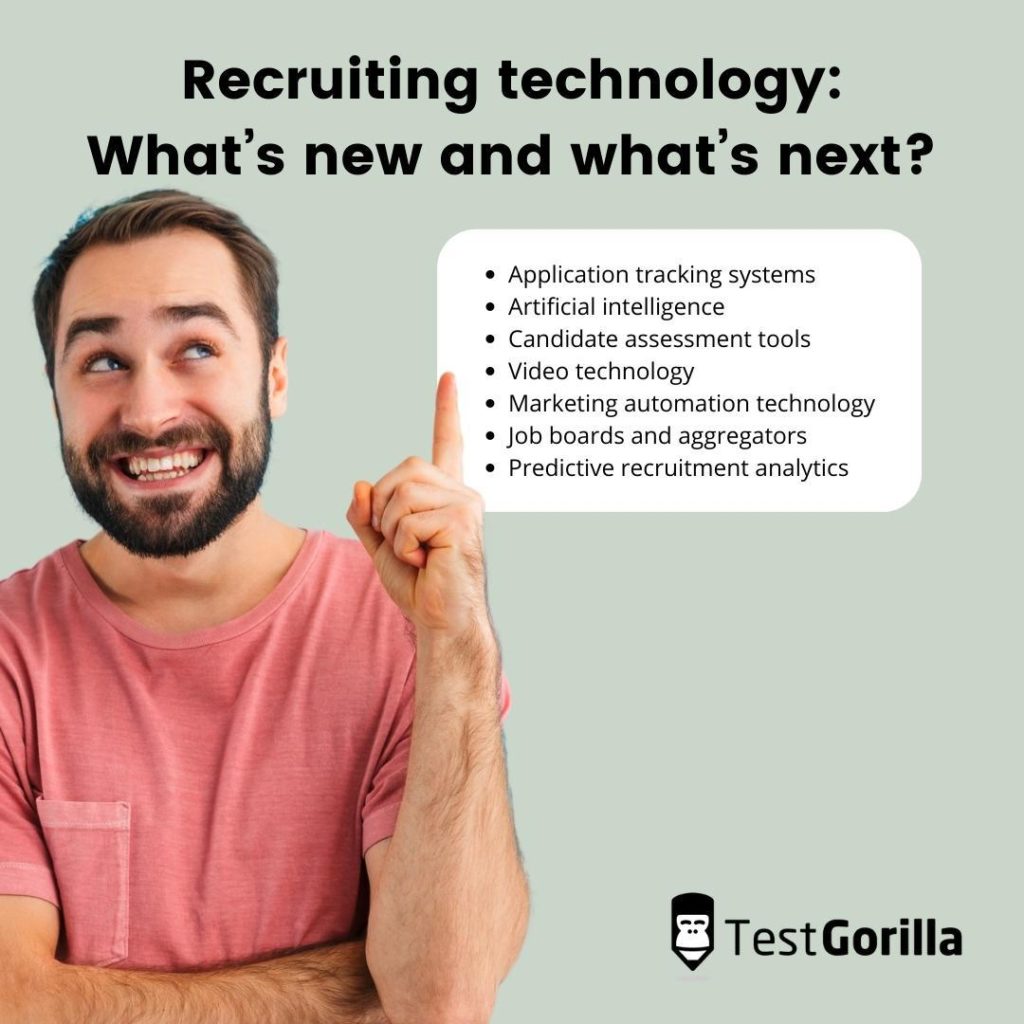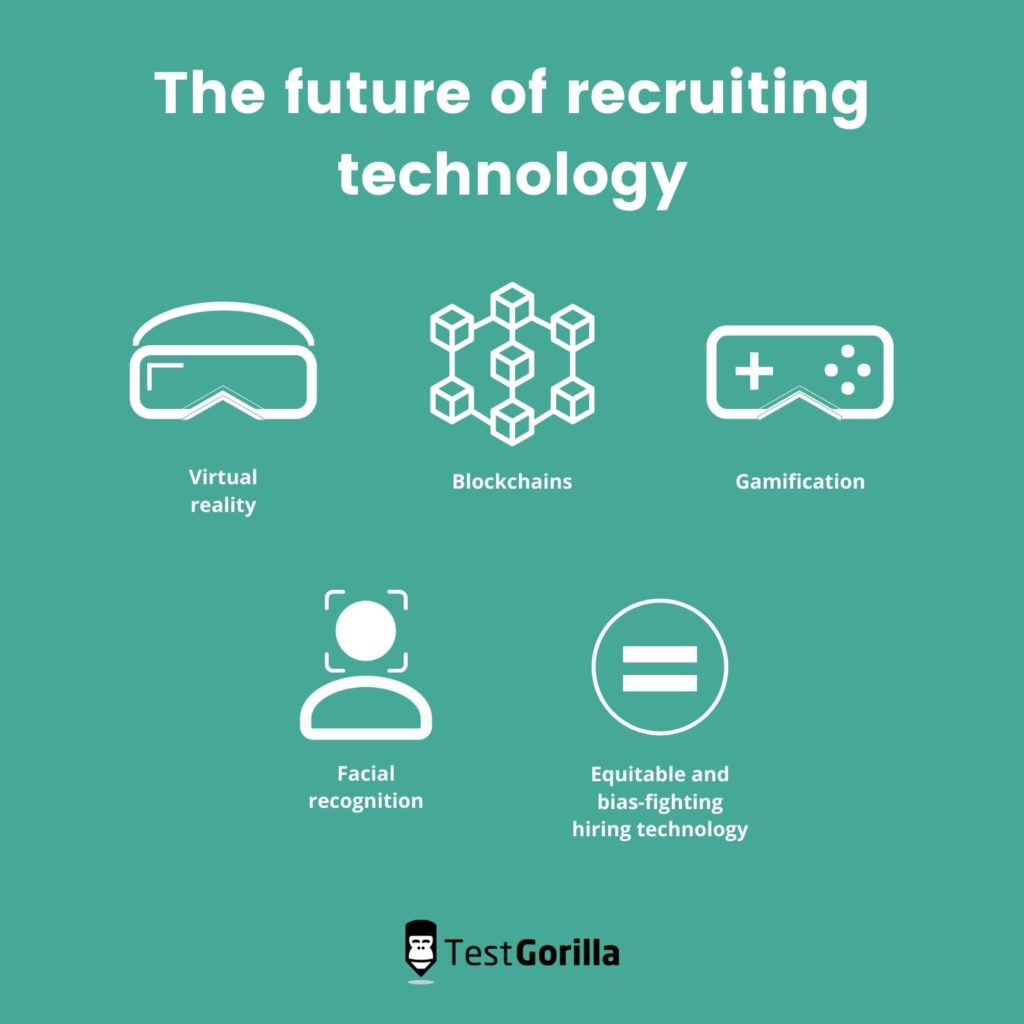Recruiting technology: What’s new and what’s next
It’s easy to forget how far recruitment technology has come in the past two decades.
Online job boards only started popping up in the late 1990s, with LinkedIn arriving in 2003. Until a few years ago, you had to rely on word-of-mouth referrals and cold-calling over actual telephones to connect with potential candidates.
Hopeful job candidates hand-delivered printed resumes, which were promptly filed away for future use (or thrown in the garbage bin).
Clearly, recruitment technology is evolving quickly, and it may look completely different by 2030.
Table of contents
- 7 major recruitment technologies and their current state right now
- 1. Applicant tracking systems
- 2. Artificial intelligence
- 3. Candidate assessment technology
- 4. Video technology
- 5. Marketing automation technology
- 6. Job boards and aggregators
- 7. Predictive recruitment analytics
- The future of recruiting technology
- Recruit better candidates with TestGorilla
7 major recruitment technologies and their current state right now
In this article, we’ll explore the current state of seven major recruitment technologies, as well as what might be around the corner.
1. Applicant tracking systems
Every company’s recruitment technology stack starts with an applicant tracking system (ATS). An ATS helps you manage the entire end-to-end recruitment process by allowing you to track candidates and organize them into one central database.
While applicant tracking systems are not a new technology, their feature sets are growing so rapidly that they barely resemble their original forms.
Modern ATSs have evolved past simple databases and grown into entire technology stacks on their own. They now include features such as:
Career page hosting
Job listing management
Job listing distribution
Application submissions
Resume screening
File storage (e.g., cover letters and resumes)
Collaboration tools
Interview templates and assessment tools
Social sharing
Onboarding tools
This feature list expands every day. Therefore, many of the other technologies on this list have already been adopted by your favorite ATS.
2. Artificial intelligence
Artificial intelligence (AI) uses computers to imitate the cognitive abilities and skills of humans.
While AI typically shows up in movies in the form of sentient killer robots, its actual intended use is to solve problems that are too complex for people to solve or to handle time-consuming tasks with near-human (or sometimes better-than-human) competency.
Here are some increasingly common uses of AI in recruiting technology:
Optical character recognition
Many ATSs give candidates the option to fill out forms by pulling the information directly from their PDF or Word resumes.
This requires complex optical character recognition (OCR) technology that detects sections of resumes, such as career experience, contact information, skills, and education.
OCR technology allows candidates to apply for roles more easily without having to repeat information.
Resume screening
AI is also used to screen candidate resumes. Rudimentary resume screening tools look for keywords in candidates’ applications to quickly sort through who may be a better fit.
However, keyword-matching tools aren’t perfect and can therefore screen out highly qualified candidates. Plus, resources have popped up to help applicants beat these systems.
More recent AI-powered resume screening tools have more advanced features, allowing companies to determine the relevance of candidates’ experiences to the role and compare them against one another.
Candidate-to-job matching
Popular platforms, such as LinkedIn Recruiter and ZipRecruiter, help you identify talent pools by providing a list of potential candidates ranked by their work experience, skills, location, and likelihood of response.
On the candidates’ side, these tools match them to jobs that are relevant to their search criteria and skill sets. Overall, these AI-powered tools make it easier for candidates and recruiters to connect with each other.
Chatbots
Chatbots are AI-powered conversation agents that simulate the experience of talking with a real person. They’re becoming increasingly common in customer service and sales scenarios but are now being adopted by hiring teams too.
In recruitment, you can use chatbots to:
Collect candidate information, such as resumes or contact information
Perform screening interviews about a candidate’s experience or skills
Answer FAQs about the application process
Schedule job interviews
The main benefit of chatbots is that they help you save time by taking over the most time-consuming administrative tasks.
3. Candidate assessment technology
Manually scanning resumes is extremely time-consuming and susceptible to unconscious hiring bias. If your company receives thousands of applications a day, it’s nearly impossible to review them all.
As we hinted above, resume screening tools have their shortcomings. They generate false positives and false negatives, and you typically can’t customize them to include all the keywords you want.
Of all methods for testing and selecting job applicants, research has repeatedly demonstrated that when you align what you measure with what you’re trying to predict, you’ll have the most success with your hiring process (e.g., Hough & Oswald, 2023). This means using different assessment methods that align with different parts of what it means to be successful on the job will give you the best results.
As a result of this research, many talent assessment tools have emerged to provide companies with better candidate screening capabilities.
For example, the pre-employment assessment tests offered by TestGorilla allow hiring teams to build packages of screening tests tailored to each role. You can issue the tests to candidates either before or after initial screening calls to assess their suitability for a position.
You can assess candidates on their:
Cognitive abilities (e.g., reading comprehension, problem-solving, or spatial reasoning)
Language proficiency (e.g., Italian, German, or French)
Personality & culture (e.g., culture add or enneagram)
Role-specific skills (e.g., financial accounting, Google Ads, or hospitality)
Software skills (e.g., Microsoft Excel, Adobe Photoshop, or Shopify)
Programming skills (e.g., Python, Ruby on Rails, or Node.js)
Situational judgment (e.g., business ethics and compliance or leadership and people management)
Skills assessment tests offer you many advantages, as they allow you to:
Screen candidates more objectively
Improve the candidate experience
Interview fewer candidates
Hire better-suited candidates and improve retention
Save on training costs
Increase profits
4. Video technology
Video has become a differentiating factor for recruiters who are looking to stand out. You can use video for:
Employer branding: Showcase your company culture with videos on your careers site and social media posts.
Job postings: Interview the hiring manager on what candidates can expect from the role to show your dedication to finding the right fit.
Candidate outreach and follow-up: Sending a one-way video message is more personalized than copy-pasted outreach messages.
Screening questions: Asking a candidate to answer screening questions via video can give you a better sense of their communication skills, personality, and knowledge.
Interviews: Most interviews these days take place over video calls rather than in person.
5. Marketing automation technology
Recruitment marketing technology leverages marketing tools for the purpose of sourcing more candidates. You can technically use generic marketing tools, but an increasing number of recruiter-specific marketing technologies have emerged in recent years.
Recruitment CRMs
CRM stands for candidate relationship management system. Often confused with an ATS, a CRM allows you to create talent pools, nurture relationships, and deliver automated marketing campaigns to passive candidates.
For example, when a new role opens up, you can use a candidate CRM to extract candidates with the relevant skills for the role and then send them a personalized email that asks them if they’re interested in the role.
This allows for mass engagement with candidates that was previously unavailable to hiring teams.
Many ATSs now contain CRM capabilities, so the line between the two technologies is blurring.
Programmatic advertising
Programmatic job advertising allows recruitment teams to automatically distribute job postings to job boards, search engines, websites, and social channels, like Facebook, Instagram, Twitter, and Reddit.
For example, many recruitment CRMs allow you to create branded ads with a few clicks by providing you with options to choose a photo, a headline, the role you want to advertise, the channel(s) you want to advertise on, and an advertising budget. The tool will then build an ad campaign tailored to people who may be interested in the role.
6. Job boards and aggregators
All recruiters should be intimately familiar with job boards, which allow you to advertise open roles.
While many job boards used to be free, most now charge on a per-posting or per-click basis, forcing you to set a monthly budget for job ads. Many ATSs and CRMs now connect directly to the most popular job boards to help you get your postings up quickly.
To help applicants sort through the now-hundreds of job boards, job aggregators (e.g., Indeed, Job Search on Google) have emerged that act as search engines for job boards. These websites automatically pull job postings from job boards and put them all in one place.
As some job aggregators can pull directly from your careers website, they may allow you to get around the need to advertise your posts on job boards.
7. Predictive recruitment analytics
Predictive analytics involves using data to forecast the future in order to make better decisions. In the context of recruitment, predictive analytics allows you to:
Improve objectivity
Hire more proactively
Track high-potential candidates
Predict candidate success
But what do predictive analytics look like in practice? One example is that your ATS can gather all kinds of data points from an applicant, including their CV, cover letter, assessments, screening interviews, social media profiles, previous experience, etc. The ATS simultaneously keeps track of historical data about current employees and their success relative to your company KPIs.
Using this data, your ATS can predict:
A candidate’s likely performance
Candidate screening lead times
The best candidate sourcing channels
Future vacancies
Retention rates
Hiring bottlenecks
Your hiring team can then take these analytics and transform them into a hiring plan.
The future of recruiting technology
While we can’t fully predict what’s next in recruiting technology, here are some technology trends that are pervasive in other industries.
1. Virtual reality
Virtual reality (VR) hasn’t quite broken through yet as an everyday technology in the workplace, but it may soon. For example, Microsoft Mesh promises to replace video calls with virtual reality meetups starting as early as 2022.
How may this impact recruiting? VR could be used to:
Give candidates a tour of the office
Interview candidates
Test candidates in real-world situations
Train and onboard candidates in simulated environments
2. Blockchains
Blockchains are another trendy technology of the future. To explain it simply, a blockchain is a highly secure form of digital storage. It can be decentralized in such a way that makes it very difficult to decrypt or reproduce.
Blockchains may play a future role in recruiting technology in the form of:
Application or credential verification
Employment or education history fact-checking
Improved candidate data storage security
3. Gamification
Gamification takes aspects of video games—such as tasks, achievements, ratings, and tokens—and applies them to the recruitment process.
While gamification in recruitment hasn’t necessarily taken off as predicted, there are technologies that allow you to assess or screen candidates through games instead of traditional applications or tests.
For example, companies can create coding games, puzzles, or simulations that put a candidate’s skills to the test.
The downside to gamification is the high costs associated with developing these games, so they’re better suited for high-volume roles that require specific cognitive skills.
4. Facial recognition
Like it or not, facial recognition technology is here to stay. It’s used to unlock your phone, track attendance at sporting events, and catch criminals on security cameras. While its use in recruitment is controversial, it has popped up in at least one tool.
The candidate assessment platform HireVue temporarily introduced facial recognition technology in 2019, claiming they could predict a candidate’s employability by the facial movements and emotions they display during an interview.
However, the company dropped its use of the technology in 2021 after a third-party audit of its algorithm determined the technology introduced hiring bias.
5. Equitable and bias-fighting hiring technology
Technology development is fuelled by demand. Therefore, recruiting technology will most likely evolve to meet the future needs of recruiters. One potential area for future technological development could be technology that helps fight recruiter bias and systemic hiring issues.
While there are tools today that can reduce bias, such as candidate assessments, we still have a long way to go to make hiring completely equitable.
For example, an AI-powered tool could strip candidate applications of racial or gender markers before they are reviewed. Or, to promote more equitable hiring, candidate assessment systems could adjust a candidate’s “ranking” based on demographic factors.
Recruit better candidates with TestGorilla
Pre-employment assessments are the first step in the future of recruiting technology. By testing candidates on the skills and cognitive abilities required for the job, you can make better, faster, and easier hiring decisions.
To start improving your hiring decisions, try TestGorilla for free today.
Or, if you’d like to learn more about the different recruiting tools you can use to improve your recruitment tech stack, head on over to this guide to recruitment tools for hiring teams.
Related posts
You've scrolled this far
Why not try TestGorilla for free, and see what happens when you put skills first.
Latest posts
The best insights on HR and recruitment, delivered to your inbox.
Biweekly updates. No spam. Unsubscribe any time.

Skills tests to hire the best
Our screening tests identify the best candidates and make your hiring decisions faster, easier, and bias-free.
Free resources
A step-by-step blueprint that will help you maximize the benefits of skills-based hiring from faster time-to-hire to improved employee retention.
With our onboarding email templates, you'll reduce first-day jitters, boost confidence, and create a seamless experience for your new hires.
This handbook provides actionable insights, use cases, data, and tools to help you implement skills-based hiring for optimal success
A comprehensive guide packed with detailed strategies, timelines, and best practices — to help you build a seamless onboarding plan.
This in-depth guide includes tools, metrics, and a step-by-step plan for tracking and boosting your recruitment ROI.
Get all the essentials of HR in one place! This cheat sheet covers KPIs, roles, talent acquisition, compliance, performance management, and more to boost your HR expertise.
Onboarding employees can be a challenge. This checklist provides detailed best practices broken down by days, weeks, and months after joining.
Track all the critical calculations that contribute to your recruitment process and find out how to optimize them with this cheat sheet.

















